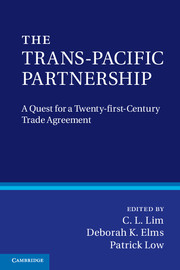Book contents
- Frontmatter
- Contents
- List of Figures and Tables
- Contributors
- Preface
- Acknowledgements
- Disclaimer
- Glossary
- Part I Introduction
- Part II The past: origins of the TPP Agreement
- Part III The present: twenty-first century elements and obstacles
- Part IV The future: high-quality meets regional and global realities
- 15 Achieving a Free Trade Area of the Asia-Pacific
- 16 APEC and the TPP
- 17 Coping with multiple uncertainties
- 18 The TPP
- 19 The TPP in a multilateral world
- Part V The TPP negotiations: the quest for quality
- Index
- References
19 - The TPP in a multilateral world
Published online by Cambridge University Press: 05 November 2012
- Frontmatter
- Contents
- List of Figures and Tables
- Contributors
- Preface
- Acknowledgements
- Disclaimer
- Glossary
- Part I Introduction
- Part II The past: origins of the TPP Agreement
- Part III The present: twenty-first century elements and obstacles
- Part IV The future: high-quality meets regional and global realities
- 15 Achieving a Free Trade Area of the Asia-Pacific
- 16 APEC and the TPP
- 17 Coping with multiple uncertainties
- 18 The TPP
- 19 The TPP in a multilateral world
- Part V The TPP negotiations: the quest for quality
- Index
- References
Summary
Introduction
Over 300 preferential trade agreements (PTAs) are currently active around the world, and many more are under negotiation. On average, each member of the World Trade Organization (WTO) belongs to no less than thirteen different PTAs. Notwithstanding the many reasons why governments might choose to participate in PTAs, the notion that this constellation of multiple, criss-crossing arrangements might in any sense be optimal invites incredulity. These overlapping agreements raise the costs of trading through multiple sets of differing rules of origin and sometimes divergent regulations. Profitable trading opportunities are likely to be fewer as a result, and scope exists for the rationalization of these agreements. Trade costs are not the only burden arising from a PTA-ridden world. The risk also exists that deep integration – increasingly going beyond the mere reduction of traditional barriers to trade such as tariffs and related trade policies – will foster regulatory divergence and market segmentation. Such segmentation may not be designed to shut out competition but rather result from the separation of negotiating venues through time and space. Even where exclusionary tendencies exist, there may be scope for extending shared benefits of integration beyond the confines of existing PTAs.
This line of argument is not entirely speculative. At least a part of what the Trans-Pacific Partnership (TPP) seeks is surely the benefits of rationalization, albeit in the context of “high-quality” deep integration. This is not the only example. In Africa, the Tripartite Free Trade Agreement (TFTA) seeks to amalgamate three regional arrangements – the Southern African Development community (SADC), the Common Market for Eastern and Southern Africa (COMESA) and the East African Community (EAC) – into a single PTA, linking 27 African economies accounting for 58 percent of the African Union’s gross domestic product and 57 percent of its population. In Latin America, “El Foro del Arco del Pacífico Latinoamericano” (known in English as the Latin-Arch Forum) is an informal grouping of eleven Spanish-speaking countries that seeks to encourage cooperation on commercial and economic matters. The Foro has working groups on trade integration, trade facilitation, promotion and protection of investment, and competitiveness.
- Type
- Chapter
- Information
- The Trans-Pacific PartnershipA Quest for a Twenty-first Century Trade Agreement, pp. 299 - 316Publisher: Cambridge University PressPrint publication year: 2012
References
- 4
- Cited by

